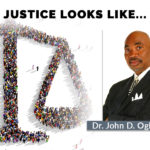EDITOR’S NOTE: “Justice looks like …” is a special series in the Voices column. Readers will have the opportunity to consider justice from numerous viewpoints. The series is based on each writer’s understanding of Scripture and relationship with Jesus Christ. Writers present their own views independent of any institution, unless otherwise noted in their bios.
You are encouraged to listen to each writer without prejudgment. Then, engage in conversation with others around you about what justice looks like to you.
Click here for more information about the series. Click here to read the full “Justice looks like…” series.
Justice looks like the Great Commandment: “Love the Lord your God with all your heart and with all your soul and with all your strength and with all your mind and, love your neighbor as yourself” (Matthew 22:37-38, Mark 12:30-31, Luke 10:27).
In Matthew, Jesus added that the Law and the demands of the prophets are based on this.
It’s that simple, but we want to complicate things. Like the lawyer in Luke 10, we ask, “Who is my neighbor?”
Laws, amendments to the U.S. Constitution and progressive codes of ethics have failed to eradicate injustice, disparity and brutality. More of the same will not yield better results.
The problem is in the human heart. We prefer to hang around people who look like us, act like us or, at least, agree with our point of view. This is exacerbated when we unfriend people on social media with whom we disagree and is accelerated by today’s cancel culture. We not only hate our enemies but also the friends of our enemies.
Like and unlike
Our desire to exclude those unlike us leads to injustice. We created deed restrictions to keep undesirable people groups out of our neighborhoods. By the time such restrictions were outlawed by the Civil Rights Act of 1968, the damage was done.
Sign up for our weekly edition and get all our headlines in your inbox on Thursdays
Poor, unrestricted neighborhoods were considered high risk and denied mortgage loans—a process known as redlining. Greenlined were the new houses in the suburbs, and, everyone who could left the deteriorating cities for better schools and safer neighborhoods—a process known as white flight.
While America officially desegregated schools, lunch counters and jobs, people continued to self-segregate in social settings. Martin Luther King Jr. repeatedly declared, “Eleven o’clock Sunday morning is the most segregated hour in America.”
Racial injustice is fueled by unfamiliarity. An August 2014 article in The Atlantic reported that 75 percent of white Americans have entirely white social networks. On the other hand, 65 percent of Black Americans have entirely Black social networks.
As a result, our understanding of people who are different from us comes from stereotypes, caricatures and media coverage that supports our prejudice.
Jesus is our example
We need to follow Jesus’ example. He was called a friend of tax collectors and sinners. He lifted the standing of women and Samaritans. He was not afraid to touch lepers. His followers would open the kingdom of God to non-Jews and a sexually altered Ethiopian.
We must move beyond protests, advocacy and sensitivity training. Like the “good” Samaritan, we must reach across to people who are different from us with acts of healing and love.
Amy Cooper, the “Central Park Karen,” illustrates how far we are from a just society. She was a professional in the finance industry and received the types of racial sensitivity training common in today’s corporate environment. In fact, when she called 911 to report a false threat, she used the politically correct term “African American.”
She knew a call from a white woman reporting an attack by a Black male will receive immediate attention that could cost the Black male his life. Regardless of her level of racism, she did not see this man as a neighbor deserving of her love.
In the aftermath, they took her dog, fired her from her job, filed criminal charges and vilified her in the media. These actions visibly demonstrate our collective outrage, but we cannot neglect to look within our own hearts. Amy Cooper’s act demonstrates the evil that lurks within ready to spring into action when triggered by the right set of circumstances.
Addressing sin
The underlying problem is sin, and the only solution is Jesus. Racial bias and all types of inequality demonstrate an absence of love for our neighbor. It is an issue Christians of all races, from the entire socioeconomic spectrum, must address together.
First, we must fellowship. We must share meals. We must work together on projects of mutual interest.
Then, we talk about deeper issues as friends, as true brothers and sisters in Christ.
We need not ever ask, “Who is my neighbor?”
Rev. Jorge Zayasbazan is the pastor of Baptist Temple in San Antonio. The views expressed are those solely of the author.
Click here to read the full “Justice looks like…” series.














We seek to connect God’s story and God’s people around the world. To learn more about God’s story, click here.
Send comments and feedback to Eric Black, our editor. For comments to be published, please specify “letter to the editor.” Maximum length for publication is 300 words.